Strategic Human Resource Management (SHRM) Discussion: Unit 1 & 2
VerifiedAdded on 2023/01/11
|11
|1550
|95
Discussion Board Post
AI Summary
This discussion post explores the multifaceted nature of employment relationships within the framework of Strategic Human Resource Management (SHRM). The author defines the employment relationship as an agreement between employer and employee, emphasizing its impact on employee satisfaction, productivity, and organizational goals. The post delves into the unitary and pluralistic approaches, highlighting their respective advantages and disadvantages in fostering employee engagement and achieving strategic objectives. It emphasizes the importance of communication, work-life balance, motivation, and conflict resolution in cultivating a positive employment relationship. The discussion also touches upon the significance of considering cost-benefit analysis when adopting either approach, and the role of unions in pluralistic settings. Furthermore, the author suggests that employers need to understand the importance of improving employment relationships to make choices that encourage employee engagement and involvement. The post concludes by underscoring the role of employees in the relationship, urging them to contribute their skills and expertise to achieve organizational goals.
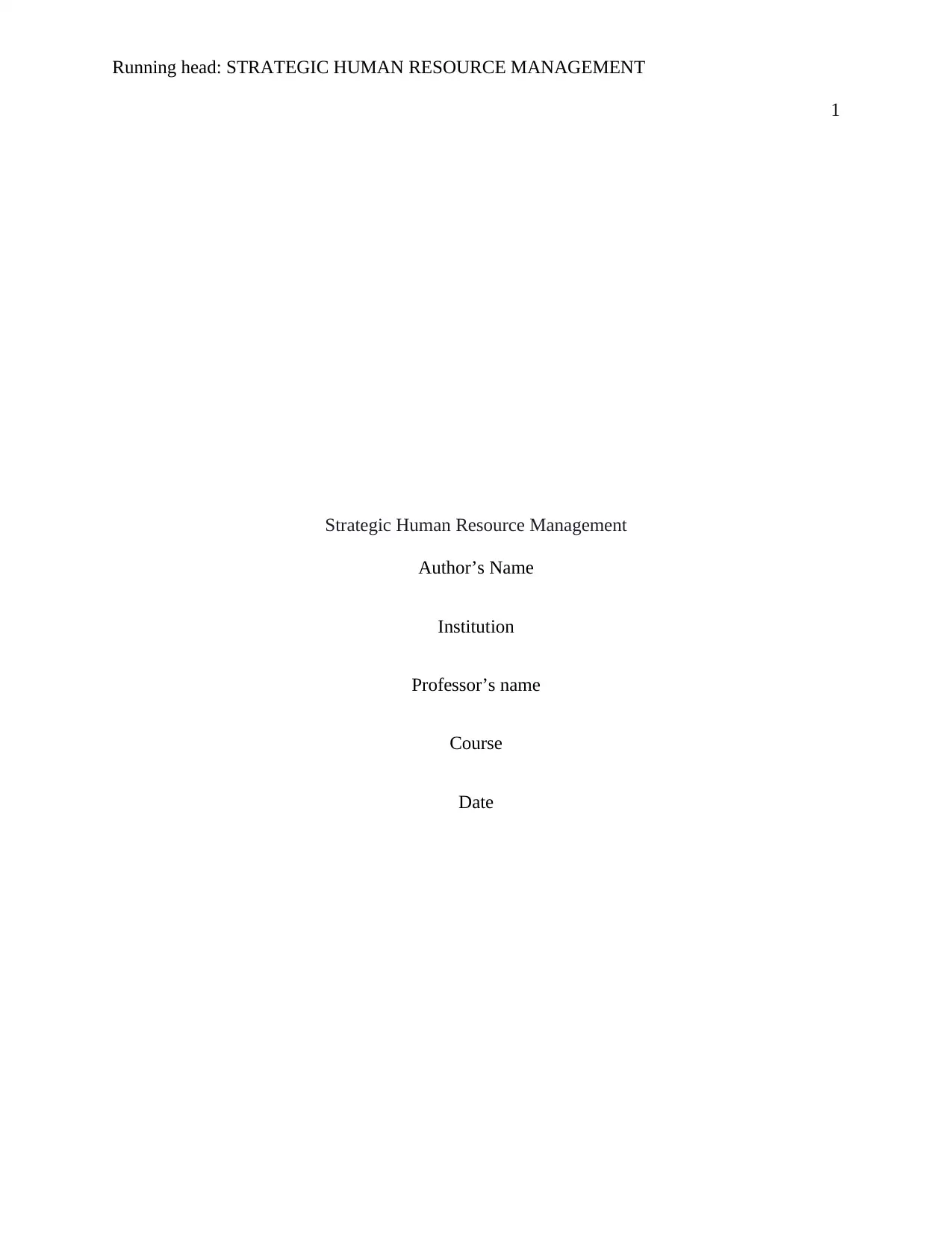
Running head: STRATEGIC HUMAN RESOURCE MANAGEMENT
1
Strategic Human Resource Management
Author’s Name
Institution
Professor’s name
Course
Date
1
Strategic Human Resource Management
Author’s Name
Institution
Professor’s name
Course
Date
Paraphrase This Document
Need a fresh take? Get an instant paraphrase of this document with our AI Paraphraser
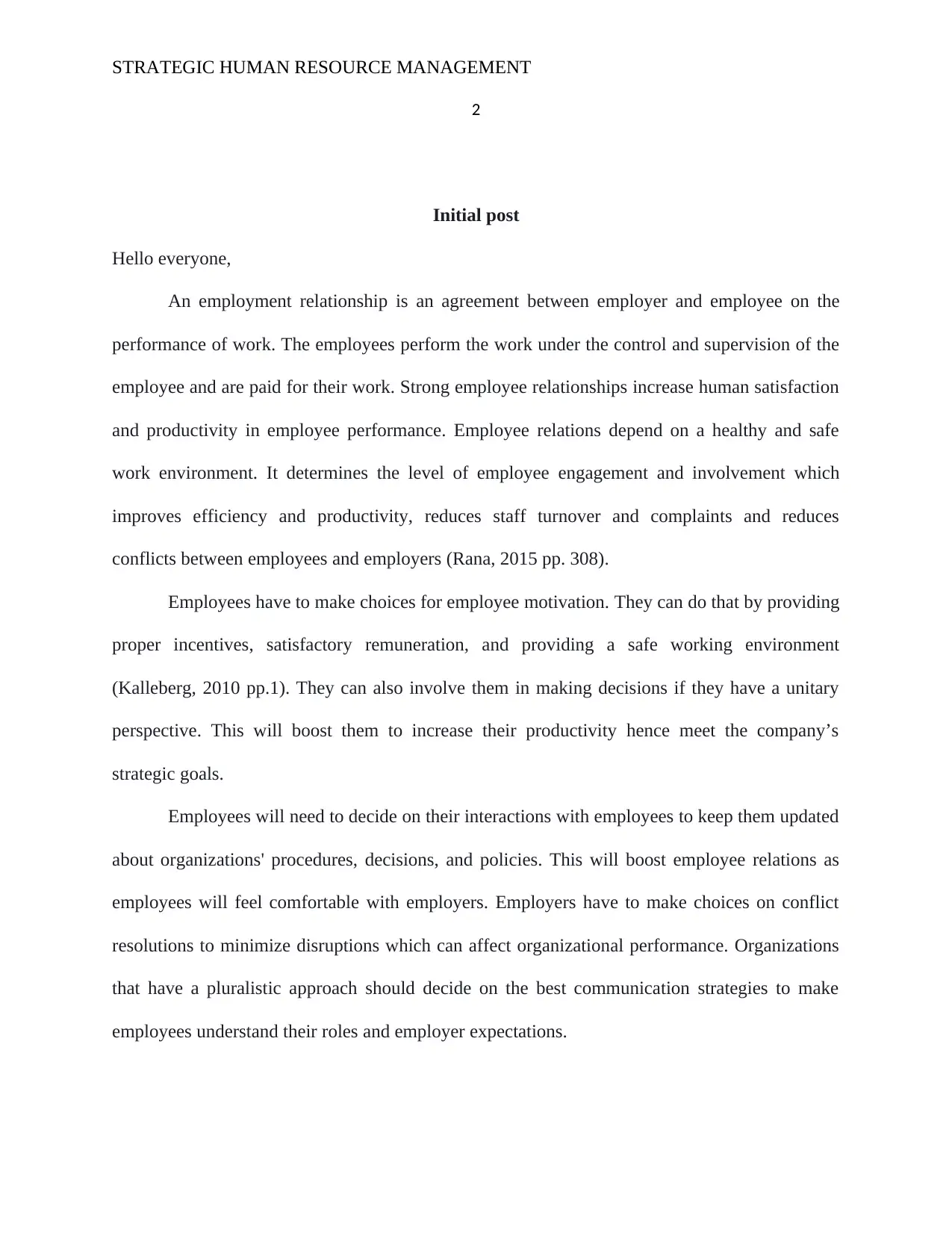
STRATEGIC HUMAN RESOURCE MANAGEMENT
2
Initial post
Hello everyone,
An employment relationship is an agreement between employer and employee on the
performance of work. The employees perform the work under the control and supervision of the
employee and are paid for their work. Strong employee relationships increase human satisfaction
and productivity in employee performance. Employee relations depend on a healthy and safe
work environment. It determines the level of employee engagement and involvement which
improves efficiency and productivity, reduces staff turnover and complaints and reduces
conflicts between employees and employers (Rana, 2015 pp. 308).
Employees have to make choices for employee motivation. They can do that by providing
proper incentives, satisfactory remuneration, and providing a safe working environment
(Kalleberg, 2010 pp.1). They can also involve them in making decisions if they have a unitary
perspective. This will boost them to increase their productivity hence meet the company’s
strategic goals.
Employees will need to decide on their interactions with employees to keep them updated
about organizations' procedures, decisions, and policies. This will boost employee relations as
employees will feel comfortable with employers. Employers have to make choices on conflict
resolutions to minimize disruptions which can affect organizational performance. Organizations
that have a pluralistic approach should decide on the best communication strategies to make
employees understand their roles and employer expectations.
2
Initial post
Hello everyone,
An employment relationship is an agreement between employer and employee on the
performance of work. The employees perform the work under the control and supervision of the
employee and are paid for their work. Strong employee relationships increase human satisfaction
and productivity in employee performance. Employee relations depend on a healthy and safe
work environment. It determines the level of employee engagement and involvement which
improves efficiency and productivity, reduces staff turnover and complaints and reduces
conflicts between employees and employers (Rana, 2015 pp. 308).
Employees have to make choices for employee motivation. They can do that by providing
proper incentives, satisfactory remuneration, and providing a safe working environment
(Kalleberg, 2010 pp.1). They can also involve them in making decisions if they have a unitary
perspective. This will boost them to increase their productivity hence meet the company’s
strategic goals.
Employees will need to decide on their interactions with employees to keep them updated
about organizations' procedures, decisions, and policies. This will boost employee relations as
employees will feel comfortable with employers. Employers have to make choices on conflict
resolutions to minimize disruptions which can affect organizational performance. Organizations
that have a pluralistic approach should decide on the best communication strategies to make
employees understand their roles and employer expectations.
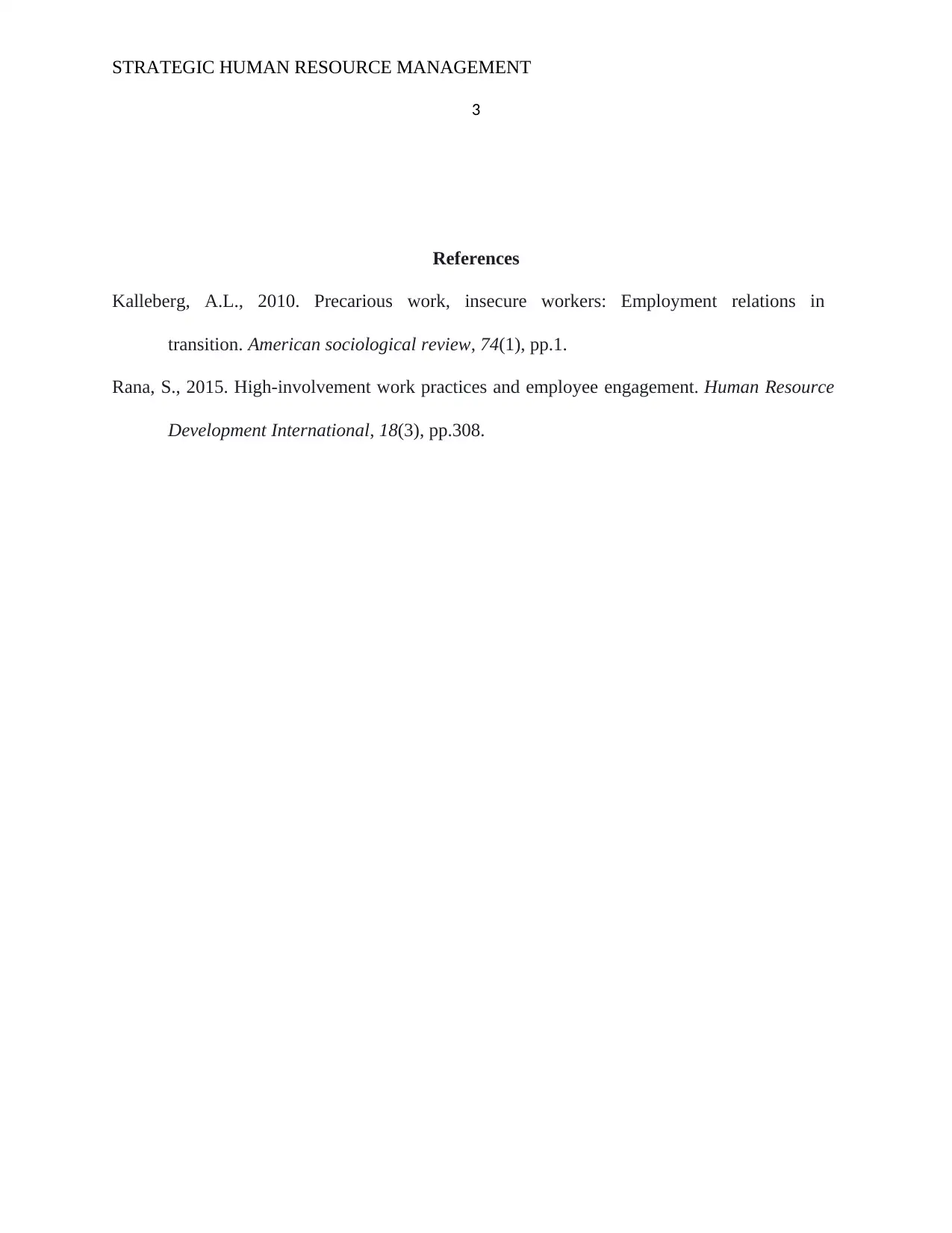
STRATEGIC HUMAN RESOURCE MANAGEMENT
3
References
Kalleberg, A.L., 2010. Precarious work, insecure workers: Employment relations in
transition. American sociological review, 74(1), pp.1.
Rana, S., 2015. High-involvement work practices and employee engagement. Human Resource
Development International, 18(3), pp.308.
3
References
Kalleberg, A.L., 2010. Precarious work, insecure workers: Employment relations in
transition. American sociological review, 74(1), pp.1.
Rana, S., 2015. High-involvement work practices and employee engagement. Human Resource
Development International, 18(3), pp.308.
⊘ This is a preview!⊘
Do you want full access?
Subscribe today to unlock all pages.

Trusted by 1+ million students worldwide
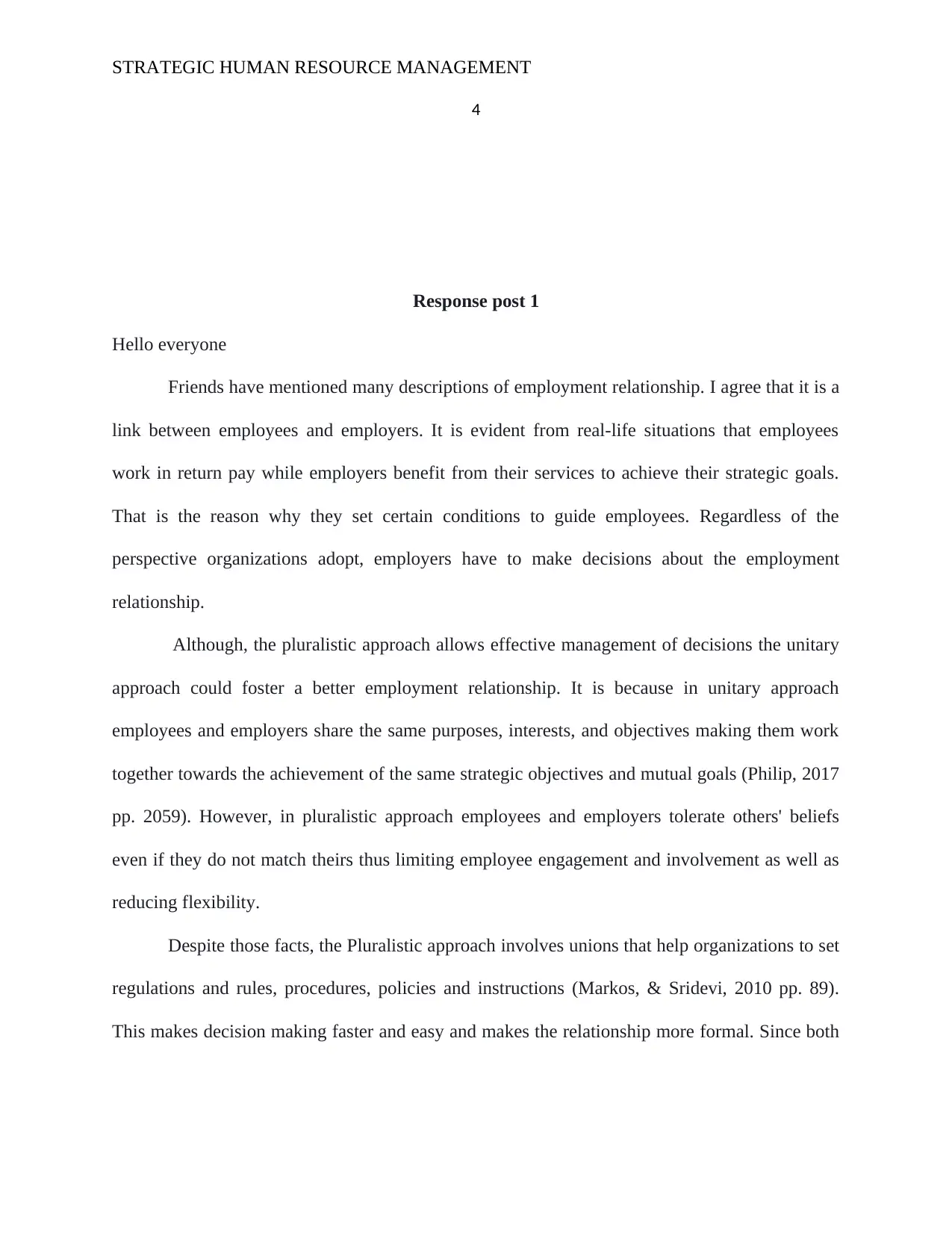
STRATEGIC HUMAN RESOURCE MANAGEMENT
4
Response post 1
Hello everyone
Friends have mentioned many descriptions of employment relationship. I agree that it is a
link between employees and employers. It is evident from real-life situations that employees
work in return pay while employers benefit from their services to achieve their strategic goals.
That is the reason why they set certain conditions to guide employees. Regardless of the
perspective organizations adopt, employers have to make decisions about the employment
relationship.
Although, the pluralistic approach allows effective management of decisions the unitary
approach could foster a better employment relationship. It is because in unitary approach
employees and employers share the same purposes, interests, and objectives making them work
together towards the achievement of the same strategic objectives and mutual goals (Philip, 2017
pp. 2059). However, in pluralistic approach employees and employers tolerate others' beliefs
even if they do not match theirs thus limiting employee engagement and involvement as well as
reducing flexibility.
Despite those facts, the Pluralistic approach involves unions that help organizations to set
regulations and rules, procedures, policies and instructions (Markos, & Sridevi, 2010 pp. 89).
This makes decision making faster and easy and makes the relationship more formal. Since both
4
Response post 1
Hello everyone
Friends have mentioned many descriptions of employment relationship. I agree that it is a
link between employees and employers. It is evident from real-life situations that employees
work in return pay while employers benefit from their services to achieve their strategic goals.
That is the reason why they set certain conditions to guide employees. Regardless of the
perspective organizations adopt, employers have to make decisions about the employment
relationship.
Although, the pluralistic approach allows effective management of decisions the unitary
approach could foster a better employment relationship. It is because in unitary approach
employees and employers share the same purposes, interests, and objectives making them work
together towards the achievement of the same strategic objectives and mutual goals (Philip, 2017
pp. 2059). However, in pluralistic approach employees and employers tolerate others' beliefs
even if they do not match theirs thus limiting employee engagement and involvement as well as
reducing flexibility.
Despite those facts, the Pluralistic approach involves unions that help organizations to set
regulations and rules, procedures, policies and instructions (Markos, & Sridevi, 2010 pp. 89).
This makes decision making faster and easy and makes the relationship more formal. Since both
Paraphrase This Document
Need a fresh take? Get an instant paraphrase of this document with our AI Paraphraser
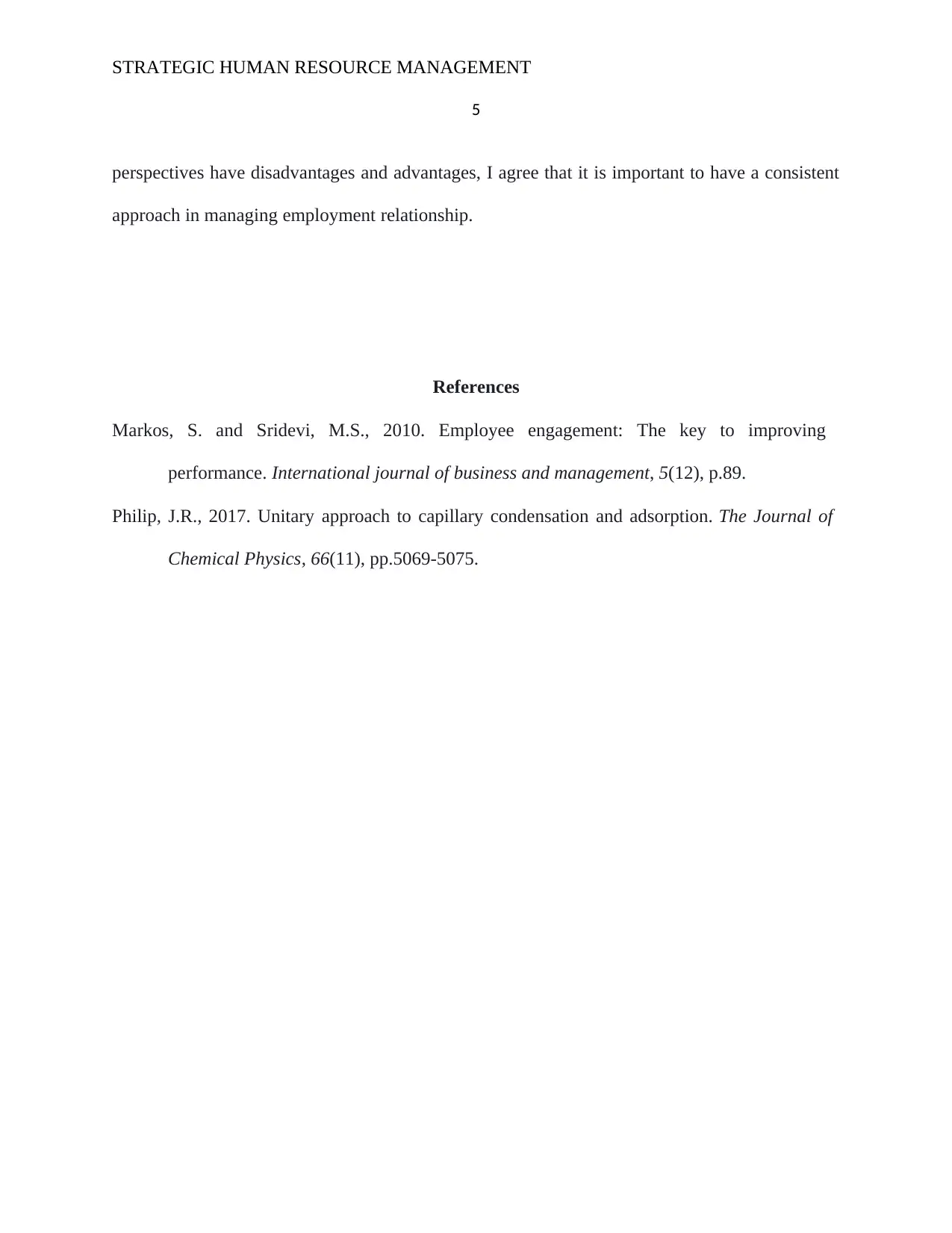
STRATEGIC HUMAN RESOURCE MANAGEMENT
5
perspectives have disadvantages and advantages, I agree that it is important to have a consistent
approach in managing employment relationship.
References
Markos, S. and Sridevi, M.S., 2010. Employee engagement: The key to improving
performance. International journal of business and management, 5(12), p.89.
Philip, J.R., 2017. Unitary approach to capillary condensation and adsorption. The Journal of
Chemical Physics, 66(11), pp.5069-5075.
5
perspectives have disadvantages and advantages, I agree that it is important to have a consistent
approach in managing employment relationship.
References
Markos, S. and Sridevi, M.S., 2010. Employee engagement: The key to improving
performance. International journal of business and management, 5(12), p.89.
Philip, J.R., 2017. Unitary approach to capillary condensation and adsorption. The Journal of
Chemical Physics, 66(11), pp.5069-5075.
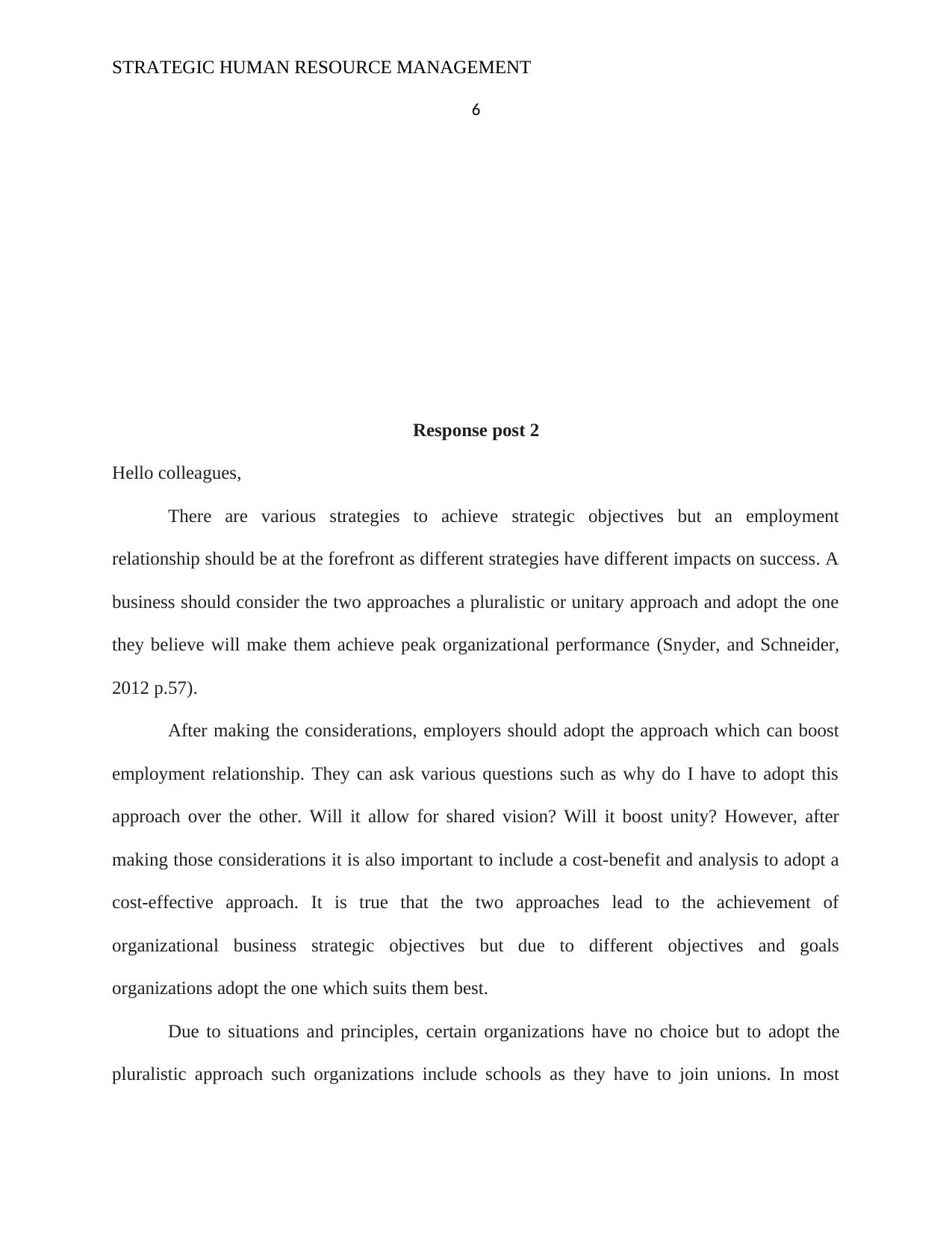
STRATEGIC HUMAN RESOURCE MANAGEMENT
6
Response post 2
Hello colleagues,
There are various strategies to achieve strategic objectives but an employment
relationship should be at the forefront as different strategies have different impacts on success. A
business should consider the two approaches a pluralistic or unitary approach and adopt the one
they believe will make them achieve peak organizational performance (Snyder, and Schneider,
2012 p.57).
After making the considerations, employers should adopt the approach which can boost
employment relationship. They can ask various questions such as why do I have to adopt this
approach over the other. Will it allow for shared vision? Will it boost unity? However, after
making those considerations it is also important to include a cost-benefit and analysis to adopt a
cost-effective approach. It is true that the two approaches lead to the achievement of
organizational business strategic objectives but due to different objectives and goals
organizations adopt the one which suits them best.
Due to situations and principles, certain organizations have no choice but to adopt the
pluralistic approach such organizations include schools as they have to join unions. In most
6
Response post 2
Hello colleagues,
There are various strategies to achieve strategic objectives but an employment
relationship should be at the forefront as different strategies have different impacts on success. A
business should consider the two approaches a pluralistic or unitary approach and adopt the one
they believe will make them achieve peak organizational performance (Snyder, and Schneider,
2012 p.57).
After making the considerations, employers should adopt the approach which can boost
employment relationship. They can ask various questions such as why do I have to adopt this
approach over the other. Will it allow for shared vision? Will it boost unity? However, after
making those considerations it is also important to include a cost-benefit and analysis to adopt a
cost-effective approach. It is true that the two approaches lead to the achievement of
organizational business strategic objectives but due to different objectives and goals
organizations adopt the one which suits them best.
Due to situations and principles, certain organizations have no choice but to adopt the
pluralistic approach such organizations include schools as they have to join unions. In most
⊘ This is a preview!⊘
Do you want full access?
Subscribe today to unlock all pages.

Trusted by 1+ million students worldwide
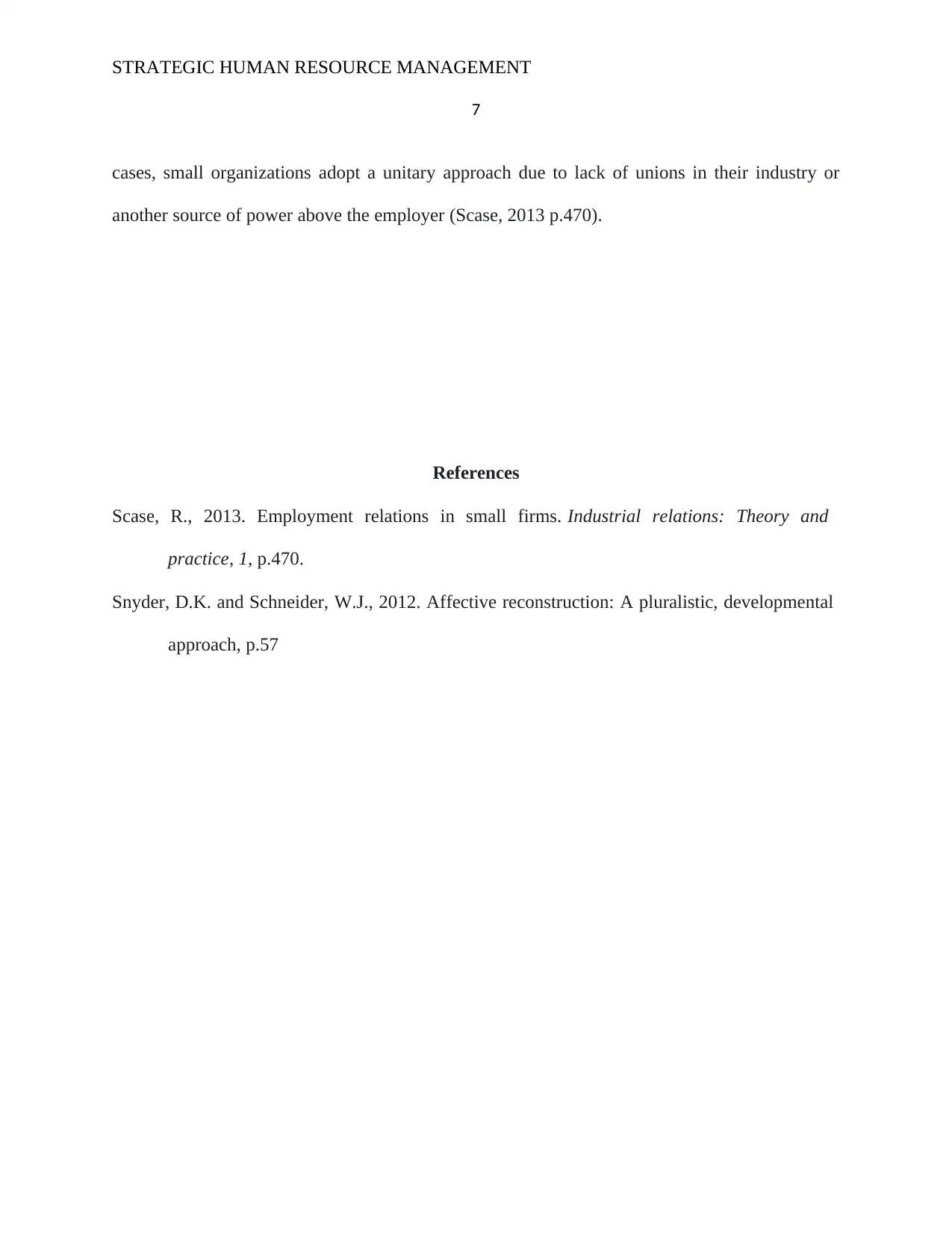
STRATEGIC HUMAN RESOURCE MANAGEMENT
7
cases, small organizations adopt a unitary approach due to lack of unions in their industry or
another source of power above the employer (Scase, 2013 p.470).
References
Scase, R., 2013. Employment relations in small firms. Industrial relations: Theory and
practice, 1, p.470.
Snyder, D.K. and Schneider, W.J., 2012. Affective reconstruction: A pluralistic, developmental
approach, p.57
7
cases, small organizations adopt a unitary approach due to lack of unions in their industry or
another source of power above the employer (Scase, 2013 p.470).
References
Scase, R., 2013. Employment relations in small firms. Industrial relations: Theory and
practice, 1, p.470.
Snyder, D.K. and Schneider, W.J., 2012. Affective reconstruction: A pluralistic, developmental
approach, p.57
Paraphrase This Document
Need a fresh take? Get an instant paraphrase of this document with our AI Paraphraser
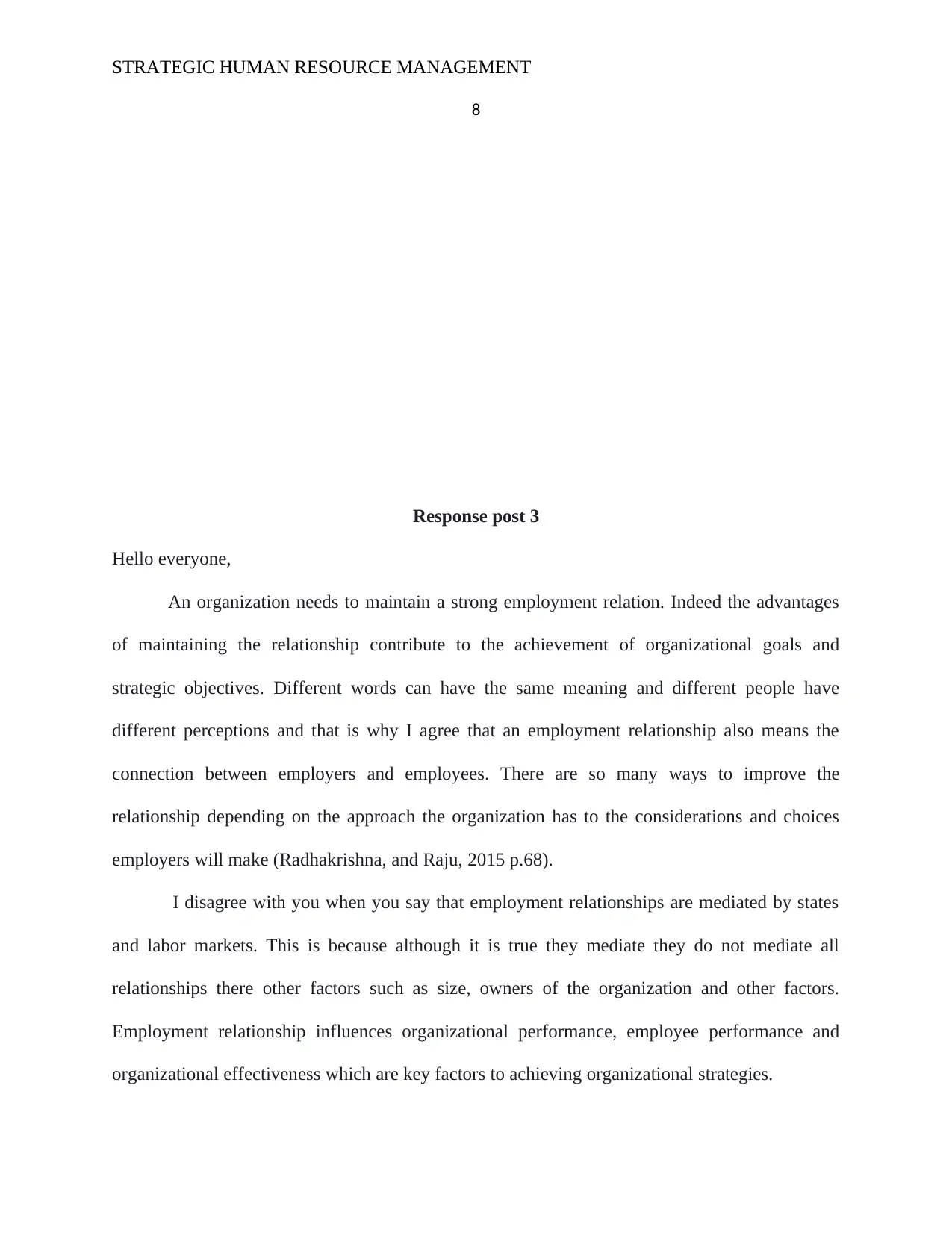
STRATEGIC HUMAN RESOURCE MANAGEMENT
8
Response post 3
Hello everyone,
An organization needs to maintain a strong employment relation. Indeed the advantages
of maintaining the relationship contribute to the achievement of organizational goals and
strategic objectives. Different words can have the same meaning and different people have
different perceptions and that is why I agree that an employment relationship also means the
connection between employers and employees. There are so many ways to improve the
relationship depending on the approach the organization has to the considerations and choices
employers will make (Radhakrishna, and Raju, 2015 p.68).
I disagree with you when you say that employment relationships are mediated by states
and labor markets. This is because although it is true they mediate they do not mediate all
relationships there other factors such as size, owners of the organization and other factors.
Employment relationship influences organizational performance, employee performance and
organizational effectiveness which are key factors to achieving organizational strategies.
8
Response post 3
Hello everyone,
An organization needs to maintain a strong employment relation. Indeed the advantages
of maintaining the relationship contribute to the achievement of organizational goals and
strategic objectives. Different words can have the same meaning and different people have
different perceptions and that is why I agree that an employment relationship also means the
connection between employers and employees. There are so many ways to improve the
relationship depending on the approach the organization has to the considerations and choices
employers will make (Radhakrishna, and Raju, 2015 p.68).
I disagree with you when you say that employment relationships are mediated by states
and labor markets. This is because although it is true they mediate they do not mediate all
relationships there other factors such as size, owners of the organization and other factors.
Employment relationship influences organizational performance, employee performance and
organizational effectiveness which are key factors to achieving organizational strategies.
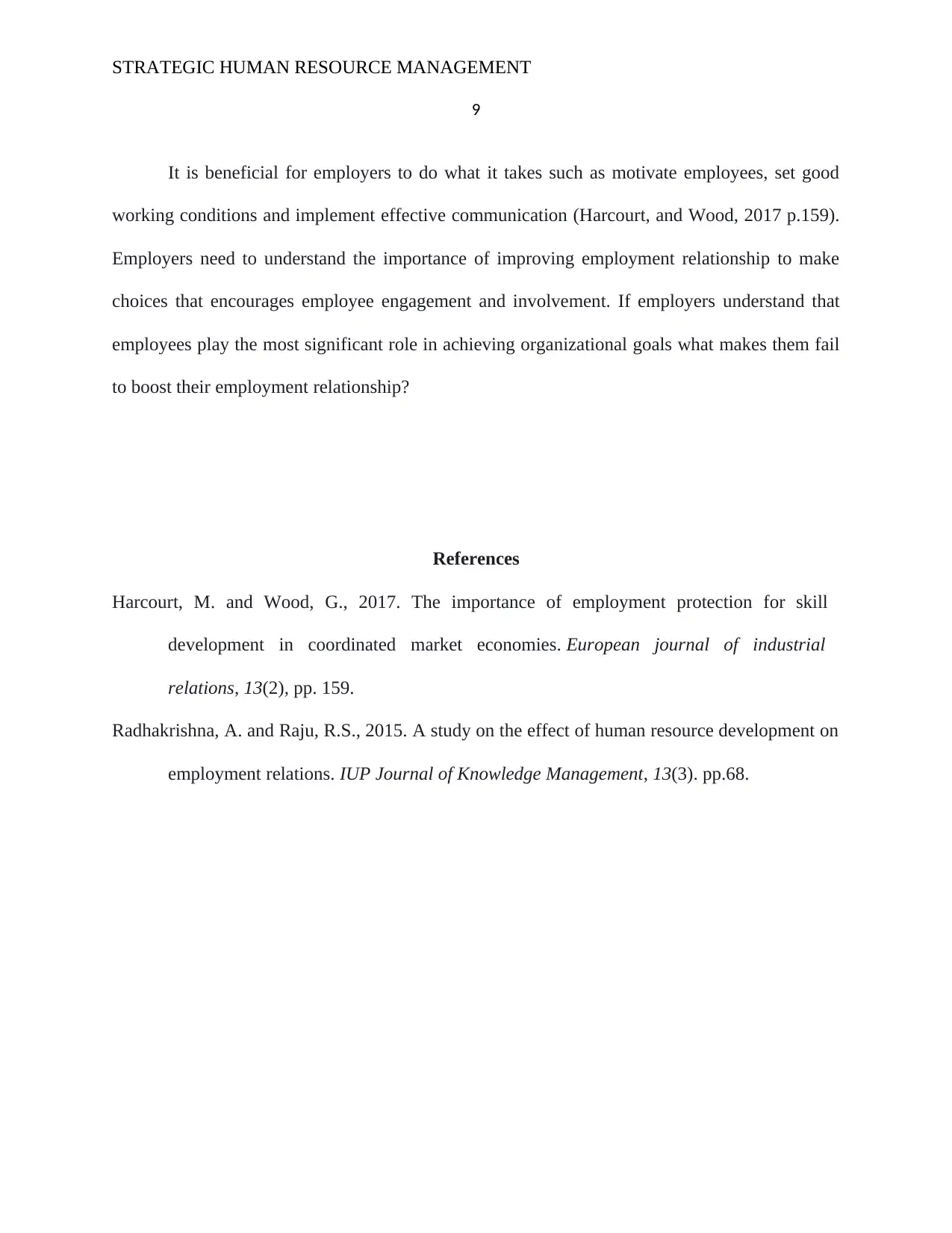
STRATEGIC HUMAN RESOURCE MANAGEMENT
9
It is beneficial for employers to do what it takes such as motivate employees, set good
working conditions and implement effective communication (Harcourt, and Wood, 2017 p.159).
Employers need to understand the importance of improving employment relationship to make
choices that encourages employee engagement and involvement. If employers understand that
employees play the most significant role in achieving organizational goals what makes them fail
to boost their employment relationship?
References
Harcourt, M. and Wood, G., 2017. The importance of employment protection for skill
development in coordinated market economies. European journal of industrial
relations, 13(2), pp. 159.
Radhakrishna, A. and Raju, R.S., 2015. A study on the effect of human resource development on
employment relations. IUP Journal of Knowledge Management, 13(3). pp.68.
9
It is beneficial for employers to do what it takes such as motivate employees, set good
working conditions and implement effective communication (Harcourt, and Wood, 2017 p.159).
Employers need to understand the importance of improving employment relationship to make
choices that encourages employee engagement and involvement. If employers understand that
employees play the most significant role in achieving organizational goals what makes them fail
to boost their employment relationship?
References
Harcourt, M. and Wood, G., 2017. The importance of employment protection for skill
development in coordinated market economies. European journal of industrial
relations, 13(2), pp. 159.
Radhakrishna, A. and Raju, R.S., 2015. A study on the effect of human resource development on
employment relations. IUP Journal of Knowledge Management, 13(3). pp.68.
⊘ This is a preview!⊘
Do you want full access?
Subscribe today to unlock all pages.

Trusted by 1+ million students worldwide
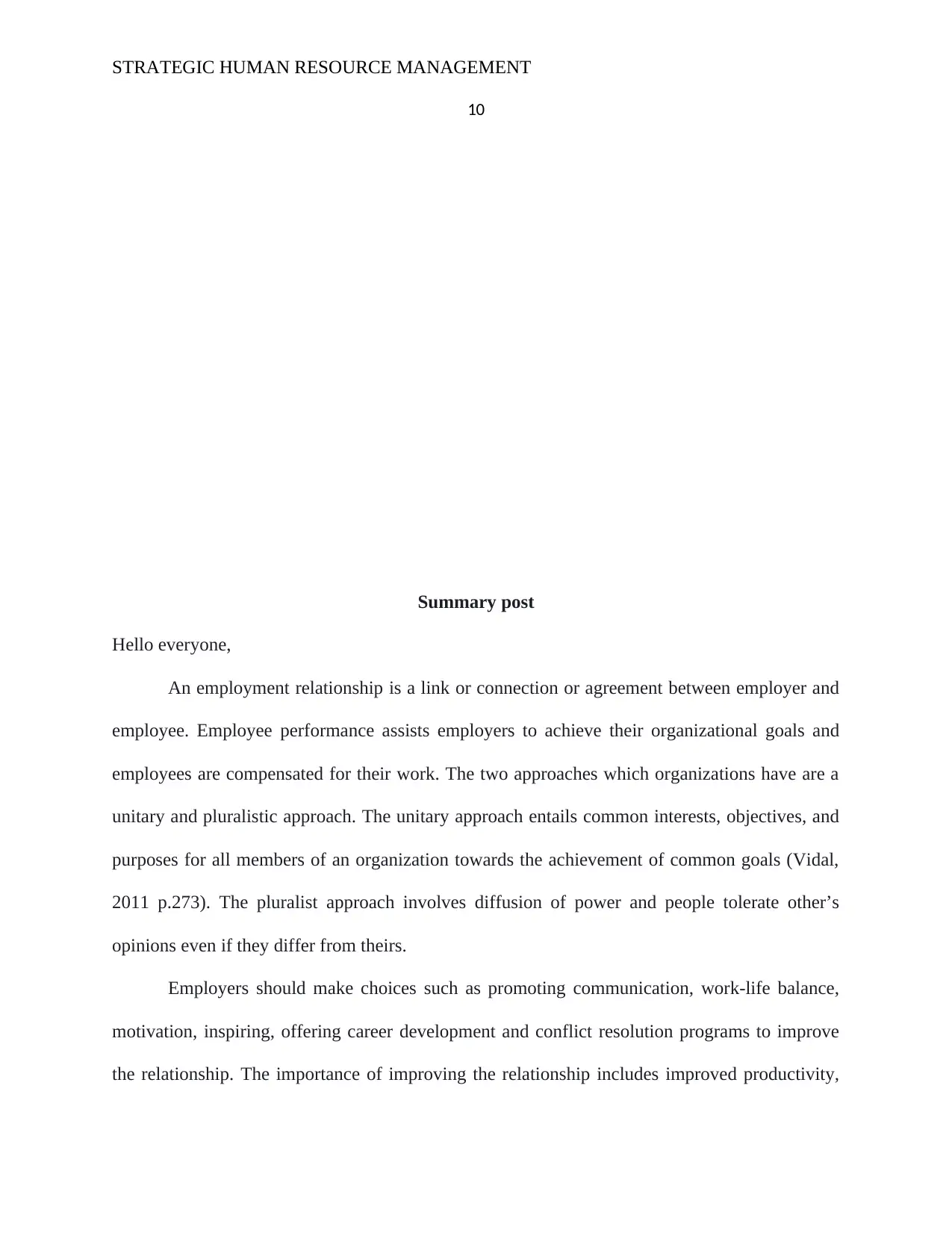
STRATEGIC HUMAN RESOURCE MANAGEMENT
10
Summary post
Hello everyone,
An employment relationship is a link or connection or agreement between employer and
employee. Employee performance assists employers to achieve their organizational goals and
employees are compensated for their work. The two approaches which organizations have are a
unitary and pluralistic approach. The unitary approach entails common interests, objectives, and
purposes for all members of an organization towards the achievement of common goals (Vidal,
2011 p.273). The pluralist approach involves diffusion of power and people tolerate other’s
opinions even if they differ from theirs.
Employers should make choices such as promoting communication, work-life balance,
motivation, inspiring, offering career development and conflict resolution programs to improve
the relationship. The importance of improving the relationship includes improved productivity,
10
Summary post
Hello everyone,
An employment relationship is a link or connection or agreement between employer and
employee. Employee performance assists employers to achieve their organizational goals and
employees are compensated for their work. The two approaches which organizations have are a
unitary and pluralistic approach. The unitary approach entails common interests, objectives, and
purposes for all members of an organization towards the achievement of common goals (Vidal,
2011 p.273). The pluralist approach involves diffusion of power and people tolerate other’s
opinions even if they differ from theirs.
Employers should make choices such as promoting communication, work-life balance,
motivation, inspiring, offering career development and conflict resolution programs to improve
the relationship. The importance of improving the relationship includes improved productivity,
Paraphrase This Document
Need a fresh take? Get an instant paraphrase of this document with our AI Paraphraser
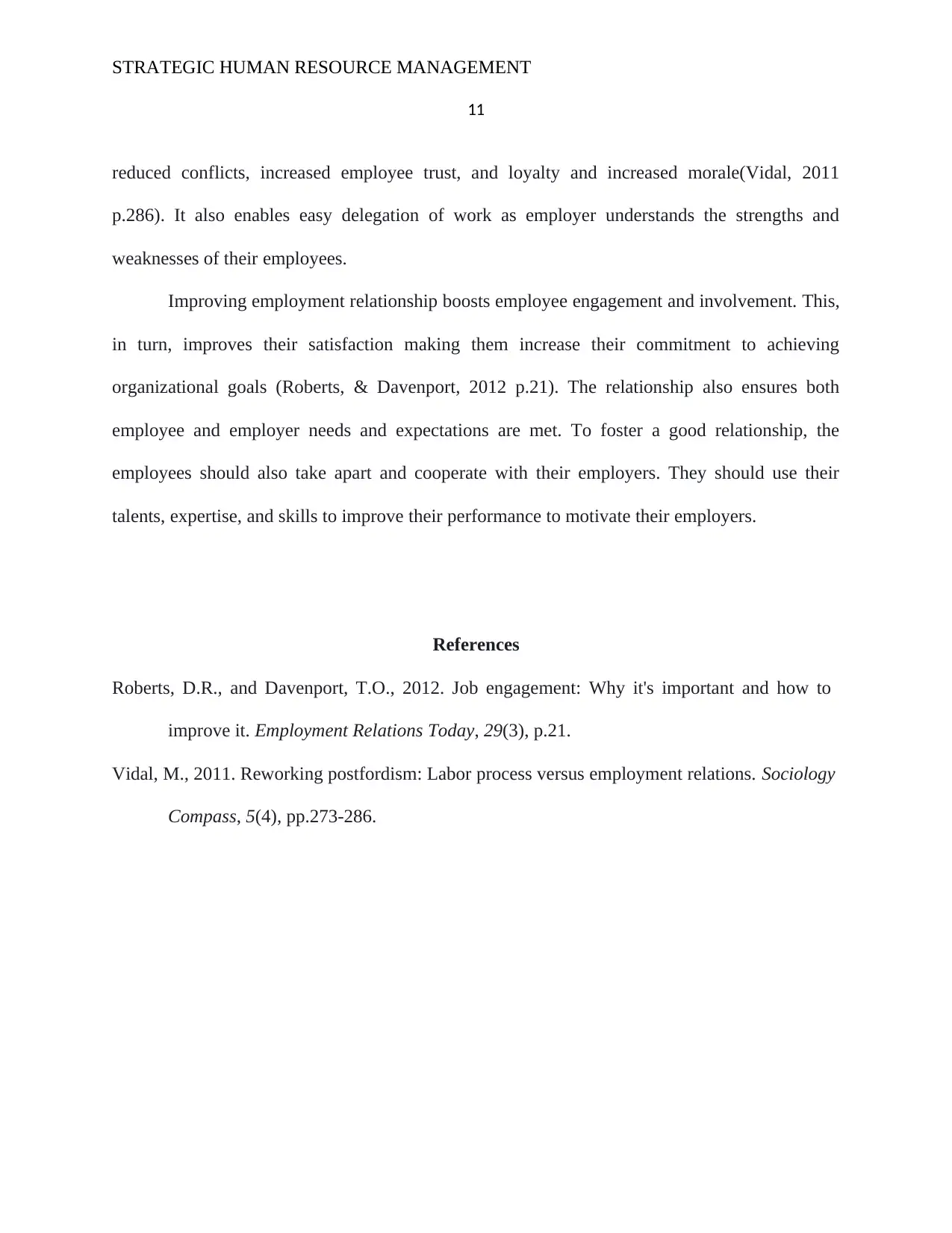
STRATEGIC HUMAN RESOURCE MANAGEMENT
11
reduced conflicts, increased employee trust, and loyalty and increased morale(Vidal, 2011
p.286). It also enables easy delegation of work as employer understands the strengths and
weaknesses of their employees.
Improving employment relationship boosts employee engagement and involvement. This,
in turn, improves their satisfaction making them increase their commitment to achieving
organizational goals (Roberts, & Davenport, 2012 p.21). The relationship also ensures both
employee and employer needs and expectations are met. To foster a good relationship, the
employees should also take apart and cooperate with their employers. They should use their
talents, expertise, and skills to improve their performance to motivate their employers.
References
Roberts, D.R., and Davenport, T.O., 2012. Job engagement: Why it's important and how to
improve it. Employment Relations Today, 29(3), p.21.
Vidal, M., 2011. Reworking postfordism: Labor process versus employment relations. Sociology
Compass, 5(4), pp.273-286.
11
reduced conflicts, increased employee trust, and loyalty and increased morale(Vidal, 2011
p.286). It also enables easy delegation of work as employer understands the strengths and
weaknesses of their employees.
Improving employment relationship boosts employee engagement and involvement. This,
in turn, improves their satisfaction making them increase their commitment to achieving
organizational goals (Roberts, & Davenport, 2012 p.21). The relationship also ensures both
employee and employer needs and expectations are met. To foster a good relationship, the
employees should also take apart and cooperate with their employers. They should use their
talents, expertise, and skills to improve their performance to motivate their employers.
References
Roberts, D.R., and Davenport, T.O., 2012. Job engagement: Why it's important and how to
improve it. Employment Relations Today, 29(3), p.21.
Vidal, M., 2011. Reworking postfordism: Labor process versus employment relations. Sociology
Compass, 5(4), pp.273-286.
1 out of 11
Related Documents
Your All-in-One AI-Powered Toolkit for Academic Success.
+13062052269
info@desklib.com
Available 24*7 on WhatsApp / Email
![[object Object]](/_next/static/media/star-bottom.7253800d.svg)
Unlock your academic potential
Copyright © 2020–2025 A2Z Services. All Rights Reserved. Developed and managed by ZUCOL.





